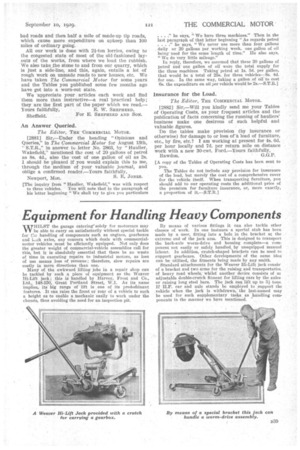Equipment for Handling Heavy Components
Page 65

If you've noticed an error in this article please click here to report it so we can fix it.
WHILST the garage cateringisolely for motorcars may be able to carry on satisfactorily without special tackle for• the handling of components such as engines, gearboxes and 1,k axles, any concern which deals with commercialmotor vehicles must be efficiently equipped. Not only does the greater weight of commercial-vehicle assemblies call for this, but it is absolutely essential that there be no waste of time in executing repairs to industrial motors, as loss of use means loss of revenue; therefore, slow repairs are costly in more directions than one.
Many of the awkward lifting jobs in a repair shop can be tackled by such a piece of equipment as the Weaver Hi-Lift jack ; this iS handled by Harvey, Frost and Co., Ltd., 148-150, Great Portland Street, W.1. As its name implies, its big range of lift is one of its predoffiinant features. It can raise the front or rear of a vehicle to such a height as to enable a mechanic easily to work under the chassis, thus avoiding the need for an inspection pit. By means of various fittings it can also tackle other classes of work. In one instance a special stub has been made by a user, fitting into a hole in the bracket at the extreme end of the jack arm. This is designed to transport the back-axle worm-drive and housing complete—a component not easily or safely handled, by unequipped manual labour. In addition, crutch-shaped brackets can be used to support gearboxes. Other developments' of the same idea can be utilized, the fitments being made by any smith.
Standard attachments for the Weaver Hi-Lift jack consis. of a bracket and two arms for the raising and transportatioi, of heavy road wheels,' whilst another device consists of al adjustable double-crutch fitment for lifting cars by the axles or raising long steel bars. The jack can lift up to 31 tons. If H.F. car and axle stands be employed to support the vehicle when the jack is withdrawn,' the last-named may be used for such supplementary tasks as handling components in the manner we have mentioned.




















































































































